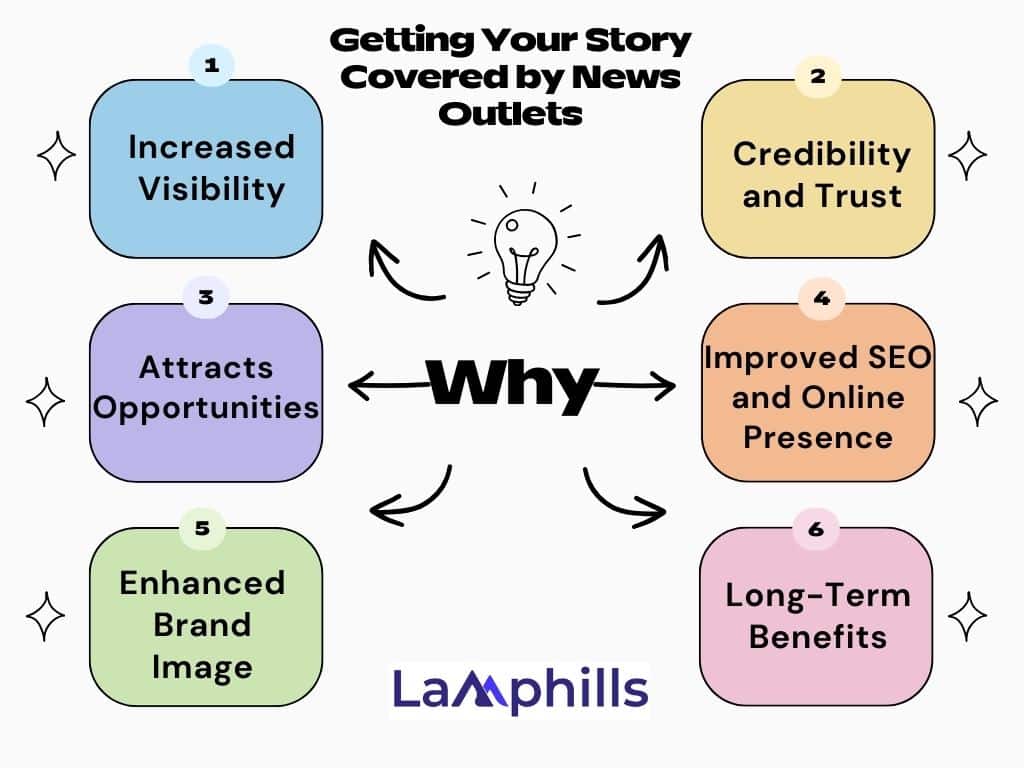If you’re looking to learn “How to Contact News Media with a Story,” this guide is for you. Getting a story covered by news outlets can seem daunting, especially if you’ve never done it before.
With big media companies everywhere and fast-growing internet and social media space, many people wonder how to get featured in news media. I remember the first time I tried to get a story into the media. I had a great piece about a community project that I thought would make headlines. But after sending out lots of emails with no response, I realized I needed a better plan.
Then I reached out to a friend who works in television broadcasting. Michael has been the head of the news department at a well-known TV agency for over six years. He offered to help me with both writing my story and contacting the news media. Before long, I had reached out to many journalists in my field, and the story about the community project was featured in three different media outlets.
This experience taught me valuable strategies for getting media coverage. Now, I want to share these tips with you. Whether you’re promoting a project, a business, or a personal story, knowing how to talk to the news media can make all the difference. In this guide, I’ll show you the steps to get your story covered by news outlets, using the experiences I have gained so far.
Key Takeaways
- News media refers to various platforms and organizations that report and disseminate news to the public. This includes traditional forms like newspapers and television, as well as digital platforms such as news websites and social media.
- There are different types of news media, each with its way of sharing news. The basic types are; Print Media, Broadcast Media, Digital Media, News Agencies, and many others.
- When your story is featured in the news, a large number of people see it. News outlets have a wide reach, meaning your story can be seen by thousands or even millions of people. This visibility can help raise awareness about your cause, business, or personal achievements.
- The first step to getting your story covered is to understand why it’s important. Journalists get many story ideas every day, so you need to make yours stand out. Ask yourself: What makes my story special? Is it timely, relevant, or unique?
Understanding the News Media
News media refers to various platforms and organizations that report and disseminate news to the public. This includes traditional forms like newspapers and television, as well as digital platforms such as news websites and social media.
These organizations collect, report, and deliver news and information to the public. They inform people about what is happening in the world, covering topics like politics, sports, weather, and entertainment. News media play a crucial role in keeping society informed and connected.
The importance of news media cannot be overemphasized. People trust it, it connects the community, and it can share your message with many people.
Types of News Media
News media is how we get information about what’s happening in the world. There are different types of news media, each with its way of sharing news. Here are the main types:
#1. Print Media
The Print media includes newspapers and magazines. They are the traditional way of getting news. People read printed articles about local, national, and international events. Newspapers often come out daily, while magazines might be weekly or monthly.
#2. Broadcast Media
The Broadcast media includes television and radio. TV news shows offer visual news with images and videos, making it easy to understand what’s happening. Radio news provides audio updates, which is helpful when you can’t watch TV, like when you’re driving.
#3. Digital Media
Online or Digital media is news shared online through websites and social media platforms. News websites update quickly and provide a lot of information. Social media allows people to share and discuss news instantly. This type of media is very popular because it’s accessible from anywhere with the internet.
Other types may include:
#4. News Agencies
News agencies are organizations that gather news and sell it to other news outlets. They don’t usually publish news directly to the public. Examples include Reuters and the Associated Press. These agencies ensure that news outlets have accurate and up-to-date information.
#5. Citizen Journalism
Citizen journalism is when regular people report news using their smartphones or computers. They might post on social media, blogs, or send videos to news outlets. This type of media is important because it can provide immediate updates from people directly involved in events.
These different types of news media are unique in each way of sharing information. From traditional newspapers to instant online updates, these different types ensure we stay informed about the world around us.
Getting your story in the news can be very helpful. When the media talks about you, it helps more people know about you, trust you, and bring new chances your way. It can also make you easier to find online. Let’s look at how being in the news can benefit you and make a positive difference.
Getting Your Story Covered by News Outlets: Why?

Getting your story covered by news outlets can bring several benefits, let me explain some of these benefits:
#1. Increased Visibility
When your story is featured in the news, a large number of people see it. News outlets have a wide reach, meaning your story can be seen by thousands or even millions of people. This visibility can help raise awareness about your cause, business, or personal achievements.
An example is when I managed to get a small charity event covered by the local news, the turnout was much higher than we expected because so many more people heard about it.
#2. Credibility and Trust
Being featured in the news adds credibility to your story. People tend to trust news sources more than advertisements or social media posts. When a reputable news outlet covers your story, it sends a message that your story is important and worth paying attention to.
This can build trust with your audience. In my experience, after a client’s business was mentioned in a well-known newspaper, they saw a significant increase in customer trust and inquiries.
#3. Attracting Opportunities
News coverage can open doors to new opportunities. Whether it’s attracting new customers, partners, or investors, being in the news can lead to valuable connections. For example, after a startup I was working with was featured in a tech magazine, they received offers from investors who were previously unaware of their innovative products.
#4. Improved SEO and Online Presence
When news outlets publish your story, they often do so online, which can improve your search engine optimization (SEO). This means your name or business appears higher in search engine results, making it easier for people to find you online. From my experience, a client’s website traffic increased noticeably after their story was covered by a major news website, leading to more online sales and inquiries.
#5. Enhanced Brand Image
Being featured in the news can enhance your brand image. It shows that your story is newsworthy and that you are doing something significant. This can improve how people perceive you or your business. I’ve seen firsthand how a positive news story can reshape public perception, turning a little-known brand into a respected name in the industry.
#6. Engagement and Interaction
News stories often spark conversations. When your story is covered, people are more likely to discuss it, share it on social media, and engage with you directly. This can lead to increased interaction with your audience. For example, after my article about a local environmental initiative was published, there was a surge in social media engagement and community involvement.
#7. Long-Term Benefits
The benefits of news coverage can be long-lasting. A single news story can continue to bring attention and opportunities for months or even years. I’ve seen businesses continue to get inquiries long after their initial news coverage, proving that the impact can be enduring.
In conclusion, getting your story covered by news outlets can bring increased visibility, credibility, opportunities, better online presence, a stronger brand image, more engagement, and long-term benefits. From my own experience working with various clients and projects, I can confidently say that news coverage can be a powerful tool for growth and success.
Getting Your Story Covered by News Outlets: How?
Getting your story covered by news media can help you. It can make more people know about you and trust you. But how do you get the media to talk about your story? Here’s how you can:
#1. Understand The Value of Your Story
The first step to getting your story covered is to understand why it’s important. Journalists get many story ideas every day, so you need to make yours stand out. Ask yourself: What makes my story special? Is it timely, relevant, or unique? When I was working on my community project, I focused on how it solved a local problem and involved key community members. Highlighting these points made our story more interesting to journalists.
#2 Research the Right Outlets and Journalists
Not all news outlets and journalists are the same. Each one has its focus and audience. To increase your chances of getting covered, you need to find the right match for your story. When I was trying to get media coverage for my project, I looked into local newspapers, TV stations, and online platforms that talked about community issues. I also found journalists who had written about similar topics before. By targeting the right places and people, I was able to make my pitch more appealing to them.
#3. Craft a Compelling Pitch
Your pitch is your chance to sell your story to the media. It needs to be clear, short, and interesting. Start with a strong opening that grabs the journalist’s attention. Then, give the main details of your story: who, what, when, where, and why. Explain why your story matters and how it fits with the journalist’s work. When I pitched my community project, I began with an important fact about the issue we were addressing and then explained how our project was helping. I also included quotes from key people to add credibility and emotion to the story.
#4. Build Relationships with Journalists
Building relationships with journalists can greatly improve your chances of getting your story covered. This means more than just sending them pitches; it involves engaging with their work, providing useful information, and being a reliable source. When I first started reaching out to journalists, I made sure to read their articles, share their work on social media, and give feedback when appropriate. Over time, I built a network of journalists who trusted me and were more likely to cover my stories.
#5. Follow Up, But Don’t Be Pushy
Following up on your pitch is important, but there’s a fine line between being persistent and being pushy. If you don’t hear back from a journalist, wait a few days before sending a polite follow-up email. In my experience, a brief, friendly reminder often prompted journalists to take a second look at my pitch. However, I always made sure not to bombard them with messages, as that could hurt the relationship.
#6. Provide Additional Resources and Be Available
Journalists often work on tight deadlines, so making their job easier can improve your chances of getting coverage. When I pitched my community project, I provided extra resources like high-quality images, background information, and contact details for interviews. I also made sure to be available for any follow-up questions or requests. By being responsive and helpful, I showed that I was a reliable source and made it easier for journalists to cover my story.
By following these steps, you can increase your chances of getting your story covered by the news. This can help more people learn about you and trust you.
Here’s a checklist on how to get your story covered by the media
How to Contact News Media with a Story
After you have selected the right news media that matches your story, follow these simple steps to reach out to them:
1. Research: Find out which news outlets cover stories like yours. Look at their websites and see the type of news they report.
2. Find Contacts: Look for contact information on their website. This might be an email address or a contact form. You can also find journalists on social media like Twitter.
3. Prepare Your Story: Write a clear and short summary of your story. Include the main points and why it’s important.
4. Write a Press Release: Create a press release with all the details of your story. Keep it simple and to the point. Include your contact information so they can reach you.
Click to learn how you can write a compelling press release with examples and templates.
5. Send Your Story: Email your press release to the journalists or news outlets. Make sure to use a catchy subject line to get their attention.
6. Follow-up: If you don’t hear back in a few days, send a polite follow-up email to check if they received your story and if they are interested.
7. Be Ready: If they contact you, be ready to provide more information or give an interview.
By following these steps, you can increase your chances of getting your story covered by the news media and reach out to the media outlet of your choice.
Challenges Facing News Media
Are you surprised to learn that news media also face challenges? Yes, it does. These include bias, where news can be slanted; misinformation and fake news spreading easily online, amongst many other challenges. Let me show you some:
#1. Bias and Objectivity
Every news organization has its way of seeing things. This means they might not always show the full picture. We need to know this and try to find news that shows different sides of a story. For example, when I read about a big event, I like to check a few different sources to see the various perspectives.
#2. Misinformation and Fake News
With the internet, it’s really easy for wrong information to spread quickly. Not everything we see online is true. That’s why it’s super important to check if the news is coming from a trusted source and to think critically about what we’re reading. From my experience, I always double-check stories with reliable sources to ensure I’m not being misled before believing or sharing them.
#3. Economic Pressures
News organizations need money to keep running, and this often comes from ads and having lots of readers. This can sometimes make them focus more on sensational stories that attract people, rather than important news. I’ve noticed that some websites are full of ads and flashy headlines, which can be distracting. It’s a good idea to support quality journalism by subscribing to trustworthy news outlets if possible.
By understanding these challenges, we can become more informed and discerning news consumers. It’s about being aware of the biases, verifying facts, and understanding the economic factors that shape the news we read and watch.
Bonus Tips on How to Contact News Media with a Story
We want your story to be shared by the media, so we have included some bonus tips in this article to make sure your story stands out and gets the attention it deserves. These bonus tips include: How to Work with News Media, Crafting Your Story Pitch, and Tips for Making Your Story Stand Out.
Tips to work with News Media
When working with the news media, here are some tips to be efficient:
1. Check Multiple Sources: Read or watch the news from various sources to get a comprehensive view of an issue. Different outlets may have different perspectives.
2. Evaluate Credibility: Look for established news organizations with a reputation for accuracy and fairness. Be cautious of sources with a known bias or poor track record.
3. Be Critical and Analytical: Think about the motives behind news stories. Consider who benefits from the information being presented and whether there might be an agenda.
4. Understand Media Literacy: Learn to recognize different types of news (e.g., hard news, opinion pieces, satire). Understanding these distinctions helps in interpreting the information correctly.
Crafting Your Story Pitch
When contacting news media, your story pitch is crucial. Here’s how to make a strong pitch:
1. Grab Attention with the Subject Line: A compelling subject line can make the difference between your email being opened or ignored. Be concise and intriguing.
2. Personalize Your Message: Mention why you think the story is a good fit for the outlet and the journalist. Reference their previous work if applicable.
3. Be Clear and Concise: Journalists are busy. Get to the point quickly, highlighting the newsworthy aspects of your story.
4. Include Supporting Material: High-quality images, videos, and data can make your story more appealing. Ensure all attachments are easy to open and view.
Tips for Making Your Story Stand Out
Most advice will tell you to have a good story and contact the right person, but here are some better strategies:
1. Create a Newsworthy Angle: Think about why your story matters now. Is there a current event or trend that ties into your story? This can make it more relevant and timely.
2. Use a Template: Having a well-structured template can save you time and ensure you include all necessary information. A template also helps maintain consistency if you’re pitching multiple outlets. I’ve used a template to streamline my pitches, ensuring each one is polished and professional.
3. Follow-up: If you haven’t heard back within a week, it’s okay to send a polite follow-up email. Sometimes, emails get lost or forgotten in the daily rush.
4. Use Social Media: Engage with journalists on social media platforms like Twitter or LinkedIn. Comment on their posts and share relevant content. This helps build a relationship before you pitch your story.
Using Templates for Success
Using a well-crafted template can greatly improve your pitching process. A good template ensures you cover all essential elements while maintaining a professional tone. It can be tailored for different stories and outlets, saving you time and effort. For instance, most templates include sections for a captivating subject line, a personalized introduction, a concise story summary, and a call to action.
By using a template that fits my story and how I want it to be shared, I’ve successfully pitched numerous stories to various media outlets, achieving consistent results.
Wrap Up
In conclusion, getting your story covered by news outlets can be challenging but with the right approach, persistence, and a touch of creativity, it’s possible. By understanding your story’s value, researching the right outlets and journalists, crafting a compelling pitch, building relationships, following up appropriately, and providing extra resources, you can increase your chances of success. From my own experience, I can say that persistence and planning pay off.
Bonus Answers to FAQs
How do I contact the media?
Most news outlets share an email or phone number for story tips. Use this contact information to reach out and share your story. Some newspapers and magazines put their contact details on the back or on the first page.
How do I pitch a story to a reporter?
Tips to Get Journalists to Read Your Pitch and Cover Your News:
1. Understand Your Audience: Know who you’re pitching to and what they’re interested in.
2. Use Email for First Contact: Send your initial pitch via email.
3. Craft an Eye-Catching Subject Line: Make your email subject line stand out.
4. Know the Audience of the Publication: Understand the readers of the publication you’re pitching to.
5. Highlight the Story: Find the compelling story within your news.
6. Be Helpful: Offer useful information and be ready to assist.
7. Avoid Attachments: Don’t include attachments in your initial email.
8. Consider Timing: Send your pitch at the right time.
9. Be Persistent (but Polite): Follow up without being rude.
How do you sell a story to the news?
To get the media interested in your story, you need a strong and interesting angle. Begin by finding news outlets that might care about your story and reach out to them with an attention-grabbing headline and an engaging summary. Make sure you have good photos or videos to go along with your story.
How do you approach a journalist to cover your story?
Use Email as Your First Contact
A phone call is straightforward, and social media has a wide audience, but 92 percent of journalists prefer receiving PR pitches through email. Emails let journalists read your message when they have time.
How to Get Media Attention for Your Cause?
1. Identify Interested Reporters: Look for journalists who write about your topic or might be interested in your cause. Check local newspapers, listen to radio shows, watch the news, and search online.
2. Reach Out: Send a brief email to these reporters. Introduce yourself and let them know about your cause.
Related Articles
Media Pitch vs. Press Release: How I Differentiate Them.
13 Digital Storytelling Examples that Will Inspire You
How to Pitch a News Story to an Editor (Expert Guide)






